
Kasukabe City in Saitama Prefecture is known as the stage of the popular manga and anime "Crayon Shin-chan", but it is also famous as a city with the world's largest underground drainage channel "Metropolitan Area Outer Underground Discharge Channel" (首都圏外郭放水路 / shutoken-gai kaku-hōsuiro).
The “Metropolitan Area Outer Underground Discharge Channel” is a flood control facility built in eastern Saitama Prefecture to reduce damage from inundation and flooding. The "Pressure-Adjustment Water Tank" with many huge pillars in the basement looks like an underground temple, and it is attracting attention on social media. In this article, we will show you the highlights of the Metropolitan Area Outer Underground Discharge Channel, plus the tour courses available.
What is the Metropolitan Area Outer Underground Discharge Channel?

The low-lying Nakagawa and Ayasegawa river basins have long been prone to water accumulation, and have always suffered from inundation and flood damage. To prevent such damage, construction of the Metropolitan Area Outer Underground Discharge Channel began in 1993 and was completed in 2006 after 13 years of work. A tunnel with a total length of 6.3km and an inner diameter of about 10m runs 50m below ground, connecting inflow facilities which take in flood water from each river, five shafts (pits), and a pressure regulating tank together.
One of the world's largest underground discharge channels, it is estimated to have reduced flood damage by approximately 127.1 billion yen for the 12 years from 2006 to 2019, yet to mention the lives and properties it has protected from.
Main facilities and disaster prevention systems
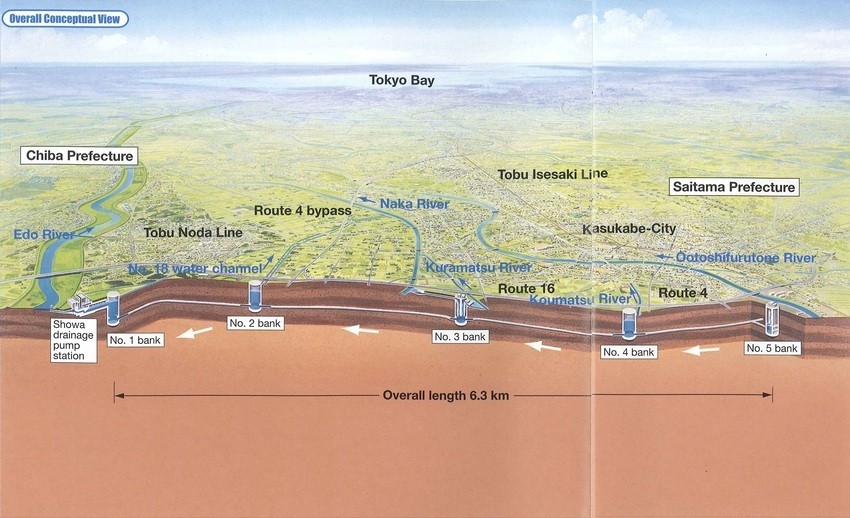
Mechanisms for adjusting floods in the Metropolitan Area Outer Underground Discharge Channel are mainly as below:
- Floods from small and medium-sized rivers are taken in from the "inflow facilities" and underground 2nd to 5th "Shafts".
- Through a tunnel with a total length of 6.3 km connecting five vertical shafts,
- Momentum of the water is weakened in the "Pressure-Adjustment Water Tank" often called by Japanese as 'Chika Shinden' (地下神殿 - underground shrine),
- Finally, the water is drained from a huge pump (drainage-pump station) through a drainage pipe into the Edogawa River.
Top Highlights①: The gigantic shaft "No. 1 Shaft"
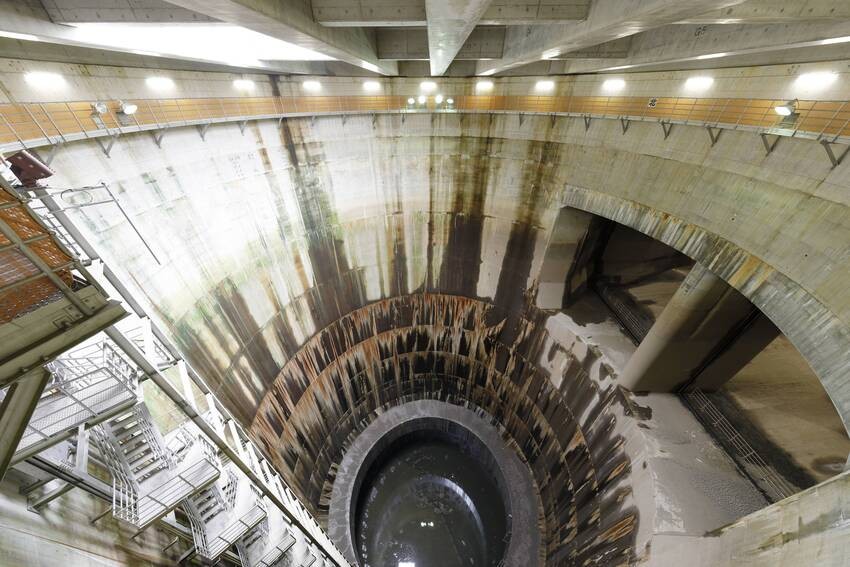
Each shaft is about 70m deep and has an inner diameter of about 30m. Unlike the other four shafts, the No. 1 Shaft does not have an "inflow facility", instead it has a role of collecting water sent from each shaft via the tunnel and flowing the accumulated water to the "Pressure-Adjustment Water Tank".
If you participate in the tour, you can look down into the shaft from above. Imagine the amount of water that can be stored from the huge size of the shaft - we're sure you can understand how useful it has been in preventing flood damage!
Top Highlights②: The "Pressure-Adjustment Water Tank" that looks like an underground shrine

The Pressure-Adjustment Water Tank is installed 22m underground, and is 177m long and 78m wide. By the way, above this on the ground level is a grass soccer field. Can you imagine that?
The main feature of the Pressure-Adjustment Water Tank is the huge pillars that stand everywhere in the water tank. There are 59 pillars, each with a length of 7m, a width of 2m, a height of 18m, and a weight of about 500 tons! If you look up from below, you will see a mystical sight that resembles a palatial shrine in ancient European mythology. Its beauty is just breathtaking!
It is also worth noting that this Pressure-Adjustment Water Tank is also used as a filming location for Japanese singers' music videos, movies and dramas. For example, it appeared as a secret hideout for the Saitama Liberation Front in the blockbuster movie "Fly Me to the Saitama" (翔んで埼玉 / Tonde Saitama), as well as in the battle scene of the well-known Kamen Rider series.
The underground exploration museum “Ryukyukan” offers free-entry!
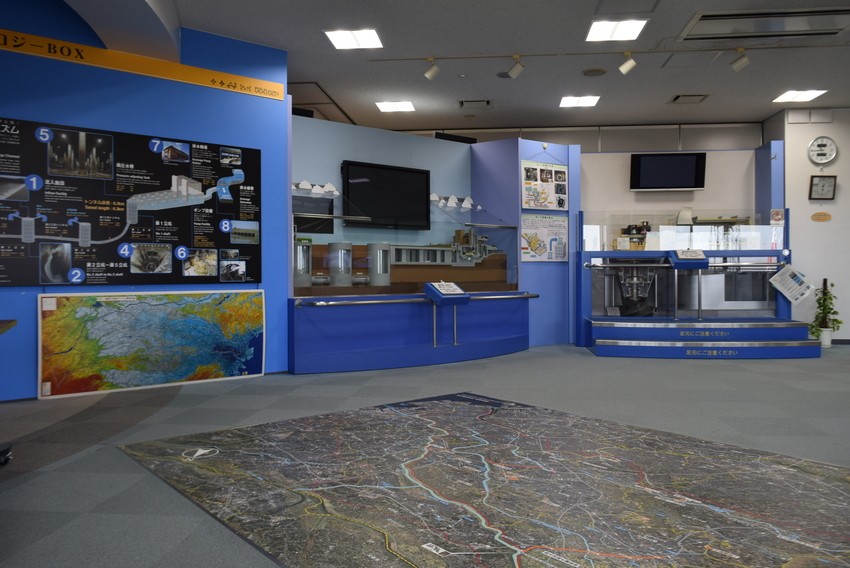
The museum "Ryukyukan (or RyuQkan)" attached to the "Drainage Pump Station" is a facility where you can enjoy photo and video exhibitions related to the function and construction of the drainage channel. In addition, through the exhibition of models, etc., you can learn about the system of each facility and pumps, and the structure of water flow from Shaft No. 1-5 to the Pressure-Adjustment Water Tank in a more enjoyable and easy-to-understand manner.
What are the Metropolitan Area Outer Underground Discharge Channel Tours, where you can also peek into the "Gigantic Shaft" and "Pressure-Adjustment Water Tank"?

If you are up for peeking into the Tokyo Metropolitan Area Outer Underground Discharge Channel, simply make a reservation from the official website and join the tours! Not only can you see the famous "Pressure-Adjustment Water Tank", but you can also look down on the 70m-deep bottom of "Shaft No. 1" from its work passage. The majestic scenery is truly extraordinary! Enjoy a special experience that you can never do in your daily life!
The tour route and participation fee differs depending on the course content. There are 4 courses in total.
①Impeller Course (new course debuted in 2022)
- Participation fee: 4,000 yen
- Course content: Ryukyukan exhibition room ⇒ Shaft No. 1 ⇒ Pressure-Adjustment Water Tank ⇒ Impeller (the bladed wheel) at the innermost part
- * Change to Shaft course when impeller is in operation
②Vertical Shaft Course
- Participation fee: 3,000 yen
- Course content: Ryukyukan exhibition room ⇒ Pressure-Adjustment Water Tank ⇒ Shaft No. 1
③Pump Course
- Participation fee: 2,500 yen
- Course content: Ryukyukan exhibition room ⇒ Pump room of Drainage-Pump Station ⇒ Pressure-Adjustment Water Tank
- *Suspended as of November 2022
④Underground Shrine Course
- Participation fee: 1,000 yen
- Course content: Pressure-Adjustment Water Tank
*If the facility is in operation after rain, there will be some changes to the course content.
*In the exhibition room of the Ryukyukan, the outline and mechanism of the flood control facility will be explained.
Reservations for tours can be made on the official website. All tours are conducted orally only in Japanese, so for safety management, if you cannot communicate in Japanese, you will need to bring a foreign language interpreter with you. Please arrange your own interpreter in advance.
How to get to the Metropolitan Area Outer Underground Discharge Channel from Tokyo
Take the Ueno-Tokyo Line or Tohoku Shinkansen from Tokyo Station, or take the Shonan-Shinjuku Line from Shinjuku Station to Omiya Station. From Omiya station, transfer to the Tobu Noda Line (Tobu Urban Park Line), get off at Minami-sakurai Station. From the north exit, take the "Kasukabe City Community Bus (Haru Bus)" or take a taxi and get off at Ryukyukan. Please note that the buses only run a fews times each day.
Spot Information
- Name: Metropolitan Area Outer Underground Discharge Channel Management Branch, Showa Drainage-Pump Station (Ryukyukan)
- Address: 720 Kamikanasaki, Kasukabe City, Saitama Prefecture
- Access: Approximately 25-30 minutes on foot (around 2.3 kilometers) from the north exit of Minami-sakurai Station, or take a bus/taxi and get off at Ryukyukan.
- HP: https://gaikaku.jp/



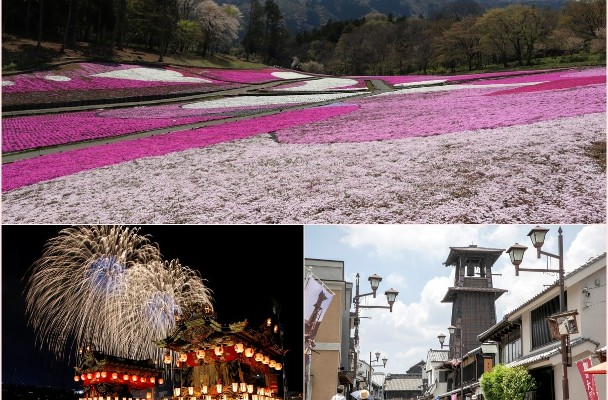
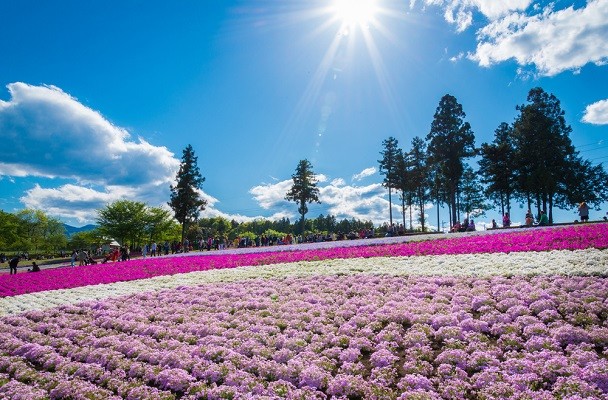
Comments